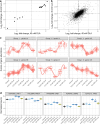Transcriptional response of Saccharomyces cerevisiae to lactic acid enantiomers
- PMID: 38229303
- PMCID: PMC10787881
- DOI: 10.1007/s00253-023-12863-z
Transcriptional response of Saccharomyces cerevisiae to lactic acid enantiomers
Abstract
The model yeast, Saccharomyces cerevisiae, is a popular object for both fundamental and applied research, including the development of biosensors and industrial production of pharmaceutical compounds. However, despite multiple studies exploring S. cerevisiae transcriptional response to various substances, this response is unknown for some substances produced in yeast, such as D-lactic acid (DLA). Here, we explore the transcriptional response of the BY4742 strain to a wide range of DLA concentrations (from 0.05 to 45 mM), and compare it to the response to 45 mM L-lactic acid (LLA). We recorded a response to 5 and 45 mM DLA (125 and 113 differentially expressed genes (DEGs), respectively; > 50% shared) and a less pronounced response to 45 mM LLA (63 DEGs; > 30% shared with at least one DLA treatment). Our data did not reveal natural yeast promoters quantitatively sensing DLA but provide the first description of the transcriptome-wide response to DLA and enrich our understanding of the LLA response. Some DLA-activated genes were indeed related to lactate metabolism, as well as iron uptake and cell wall structure. Additional analyses showed that at least some of these genes were activated only by acidic form of DLA but not its salt, revealing the role of pH. The list of LLA-responsive genes was similar to those published previously and also included iron uptake and cell wall genes, as well as genes responding to other weak acids. These data might be instrumental for optimization of lactate production in yeast and yeast co-cultivation with lactic acid bacteria. KEY POINTS: • We present the first dataset on yeast transcriptional response to DLA. • Differential gene expression was correlated with yeast growth inhibition. • The transcriptome response to DLA was richer in comparison to LLA.
Keywords: Budding yeast; D-lactate; L-lactate; Lactic acid; Low pH stress; RNA-seq.
© 2024. The Author(s).
Conflict of interest statement
The authors declare no competing interests.
Figures




Similar articles
-
Physiological and transcriptional responses to high concentrations of lactic acid in anaerobic chemostat cultures of Saccharomyces cerevisiae.Appl Environ Microbiol. 2008 Sep;74(18):5759-68. doi: 10.1128/AEM.01030-08. Epub 2008 Aug 1. Appl Environ Microbiol. 2008. PMID: 18676708 Free PMC article.
-
Construction of lactic acid-tolerant Saccharomyces cerevisiae by using CRISPR-Cas-mediated genome evolution for efficient D-lactic acid production.Appl Microbiol Biotechnol. 2020 Nov;104(21):9147-9158. doi: 10.1007/s00253-020-10906-3. Epub 2020 Sep 22. Appl Microbiol Biotechnol. 2020. PMID: 32960291
-
Metabolic Engineering and Adaptive Evolution for Efficient Production of l-Lactic Acid in Saccharomyces cerevisiae.Microbiol Spectr. 2022 Dec 21;10(6):e0227722. doi: 10.1128/spectrum.02277-22. Epub 2022 Nov 10. Microbiol Spectr. 2022. PMID: 36354322 Free PMC article.
-
Mechanisms of iron sensing and regulation in the yeast Saccharomyces cerevisiae.World J Microbiol Biotechnol. 2017 Apr;33(4):75. doi: 10.1007/s11274-017-2215-8. Epub 2017 Mar 17. World J Microbiol Biotechnol. 2017. PMID: 28315258 Review.
-
Post-transcriptional regulation of gene expression in response to iron deficiency: co-ordinated metabolic reprogramming by yeast mRNA-binding proteins.Biochem Soc Trans. 2008 Oct;36(Pt 5):1088-90. doi: 10.1042/BST0361088. Biochem Soc Trans. 2008. PMID: 18793194 Review.
Cited by
-
Transcriptomic Identification of Core Regulatory Genes for Higher Alcohol Production in Saccharomyces cerevisiae at Different Sugar Concentrations in Wine Fermentation.Foods. 2025 Apr 23;14(9):1476. doi: 10.3390/foods14091476. Foods. 2025. PMID: 40361559 Free PMC article.
-
Factors Affecting D-Lactic Acid Production by Flocculant Saccharomyces cerevisiae Under Non-Neutralizing Conditions.Microorganisms. 2025 Mar 7;13(3):618. doi: 10.3390/microorganisms13030618. Microorganisms. 2025. PMID: 40142511 Free PMC article.
References
-
- Abbott DA, Knijnenburg TA, De Poorter LM, Reinders MJ, Pronk JT, Van Maris AJ (2007) Generic and specific transcriptional responses to different weak organic acids in anaerobic chemostat cultures of Saccharomyces cerevisiae. FEMS Yeast Res 7:819–833. 10.1111/j.1567-1364.2007.00242.x - PubMed
-
- Baek S-H, Kwon EY, Kim YH, Hahn J-S (2016) Metabolic engineering and adaptive evolution for efficient production of D-lactic acid in Saccharomyces cerevisiae. Appl Microbiol Biotechnol 100:2737–2748. 10.1007/s00253-015-7174-0 - PubMed
-
- Baker Brachmann C, Davies A, Cost GJ, Caputo E, Li J, Hieter P, Boeke JD (1998) Designer deletion strains derived from Saccharomyces cerevisiae S288C: a useful set of strains and plasmids for PCR-mediated gene disruption and other applications. Yeast 14:115–132. 10.1002/(SICI)1097-0061(19980130)14:2%3c115::AID-YEA204%3e3.0.CO;2-2 - PubMed
MeSH terms
Substances
Grants and funding
LinkOut - more resources
Full Text Sources
Molecular Biology Databases

